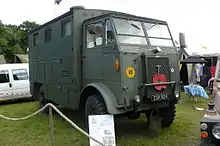Thornycroft
Thornycroft was an English vehicle manufacturer which built coaches, buses, and trucks from 1896 until 1977.
 Preserved 1934 Thornycroft Handy dropside lorry | |
| Type | Manufacturing |
|---|---|
| Industry | Road vehicles |
| Fate | Taken over |
| Successor | Scammell |
| Founded | 1896 in Chiswick, England |
| Founder | John Isaac Thornycroft |
| Defunct | 1977 |
| Owner | British Leyland |
History

.jpg.webp)
In 1896, naval engineer John Isaac Thornycroft formed the Thornycroft Steam Carriage and Van Company which built its first steam van. This was exhibited at the Crystal Palace Show, and could carry a load of 1 ton. It was fitted with a Thornycroft marine launch-type boiler (Thornycroft announced a new boiler designed for its steam carriages in October 1897[1]). The engine was a twin-cylinder compound engine arranged so that high-pressure steam could be admitted to the low-pressure cylinder to give extra power for hill-climbing.[2] A modified version of the steam wagon with a 6-cubic-yard tipper body was developed for Chiswick council in 1896 and went into service as a very early self-propelled dust-cart. While the original 1896 wagon had front-wheel drive with rear-wheel steering, the tipper dust-cart had rear-wheel drive and front-wheel steering. The Thornycroft tipper was built by the Bristol Wagon & Carriage Works, though engined by Thornycroft.[3]
Thornycroft's first petrol vehicle was built in 1902,[4] and the company completed the move into internal combustion engine power in 1907.
Thornycroft's Basingstoke factory supplied nearly 5,000 motor vehicles for the World War I effort. It also provided large numbers of engines of various powers to the Admiralty, War Office and other government departments at the beginning of the war and for the next two years. Thereafter the Basingstoke factory manufactured marine engines for the Coastal Motor Boats being built at the John I. Thornycroft & Company works in Woolston, Southampton. It also made the Thornycroft depth-charge thrower for anti-submarine warfare.[5]
From 1931, Thornycroft used names for its vehicle range – descriptive and colourful ones. During World War II the company designed the Terrapin[6] and other war-related vehicles.
In 1948, the company name was changed to Transport Equipment (Thornycroft) Ltd to prevent confusion with the shipbuilding Thornycroft company. The company was well known for providing fire engine chassis, with multi-axle drive for uses such as airports. A limited number of 4x4 chassis were also provided to Worcester-based fire engine manufacturer, Carmichael for sale to civilian brigades in the 1950s.
Thornycroft was taken over on 1 March 1961 by AEC parent Associated Commercial Vehicles (ACV),[7][8][9] with production limited to Antars, Big Bens and Nubians, although the Thornycroft-designed six-speed constant mesh gearbox was used in AEC and later medium weight Albion and Leyland trucks.[10] ACV was taken over by Leyland in 1962. Leyland already had a specialist vehicle unit in Scammell. Vehicle production at Basingstoke ceased in 1969 with production transferred to Scammell at Watford.[11] The factory continued to manufacture gearboxes. It was sold in 1972 to Eaton Corporation.[12]
Models
Bus and coach

- Type J
- Beautyride
- Boudicea
- Cygnet (Single Deck)
- Daring (Double Deck)
- Lightning
- Nippy
- Patrician
Lorry


.jpg.webp)
_(33360641336).jpg.webp)
- four-wheel drive artillery tractor for the army
- A1 RSW / A3 RSW, an off-road capable rigid six-wheeler to an army specification, 1926[13]
- QC / Dreadnought, 1930
- 12 ton rigid six-wheel chassis.[14]
- Hardy
- Dandy
- Sturdy - 5/6 tonner
- Trusty - 8 ton forward control 4 wheeler
- Bullfinch
- Strenuous
- Mastiff
- Tartar 3-ton 6x4, both civilian & military versions and production (3,000 - 4,000) between 1938 and 1945.
- (see Thornycroft Bison for an unusual variant)
- Taurus
- Iron Duke
- Amazon
- Stag
- Bulldog
- Jupiter - 6.5 ton
- Nubian
- 3-ton vehicle
- Available as 4 x 4, 6 x 4, 6 x 6
- Big Ben
- Antar
- 85-ton
- 6 x 4 pipeline and tank transporter
- Swift
- Trident
See also
- Thornycroft military vehicles
- Thornycroft Athletic F.C.
References
- "Messrs Thornycroft's new Automotor boiler", The Automotor and Horseless Carriage Journal, October 1897, pp2-4
- "Recent Developments in Mechanical Road Carriages", The Automotor and Horseless Vehicle Journal, December 1896, pp89-91
- "An automobile dust-cart", The Automotor and Horseless Carriage Journal, Oct 1897, p24
- Richard Twelvetrees (1946). Thornycroft Road Transport Golden Jubilee: 50 Years of Commercial and Military Vehicle Development by Private Enterprise. J.I. Thornycroft.
- Chairman's report (John E Thornycroft) to Annual General Meeting of John I. Thornycroft & Co. (Limited). The Times, Saturday 14 June 1919; pg. 20; Issue 42126
- Chris Bishop (2002). The Encyclopedia of Weapons of World War II. Sterling Publishing Company, Inc. pp. 66–. ISBN 978-1-58663-762-0.
- AEC Thornycroft no change for present Commercial Motor 10 February 1961 page 37
- AEC-Thornycroft Merger Announced in England Truck & Bus Transportation March 1961 page 5
- Passenger Transport. Ian Allan, Modern Transport Publishing Company. 1961.
- £1m of New Plant for Thornycroft Works Commercial Motor 5 January 1962 page 42
- John Carroll; Peter James Davies (2007). Complete Book Tractors and Trucks. Hermes House. ISBN 978-1-84309-689-4.
- Thornycroft to leave Basingstoke Commercial Motor 12 January 1973 page 28
- "Type A1 RSW". Hants gov, Thornycroft. Archived from the original on 29 May 2008.
- "Type QC lorry". Hants gov, Thornycroft. Archived from the original on 13 March 2012.
External links
| Wikimedia Commons has media related to Thornycroft vehicles. |
| External image | |
|---|---|
- 'Thornycroft of Basingstoke' - (Hampshire Cultural Trust) - extensive coverage of history and vehicles
- Thornycroft vehicle preservation group
- Thorneycroft Classic Motor History
- Youtube video of an existing Thorneycroft rifle in the Royal Armories in Leeds, England
